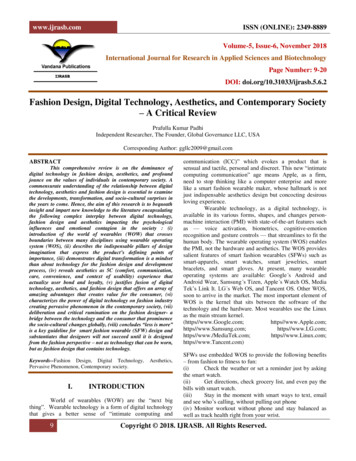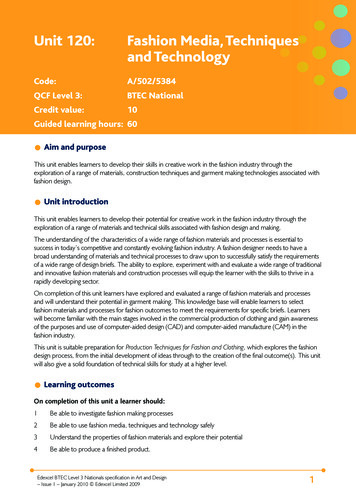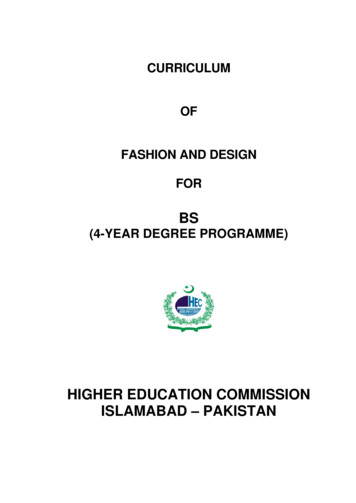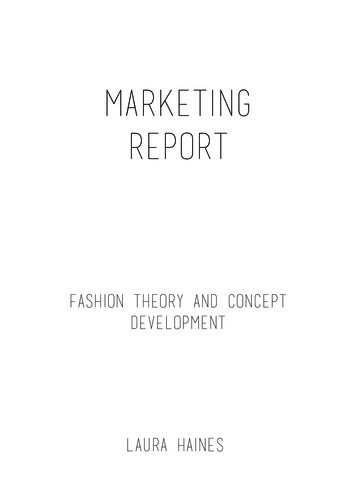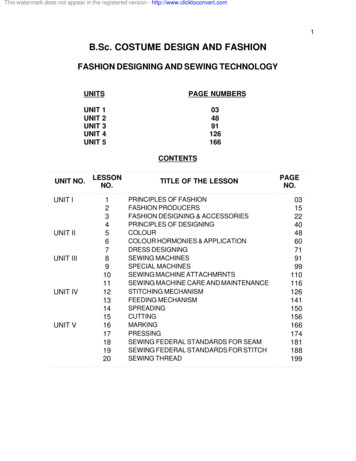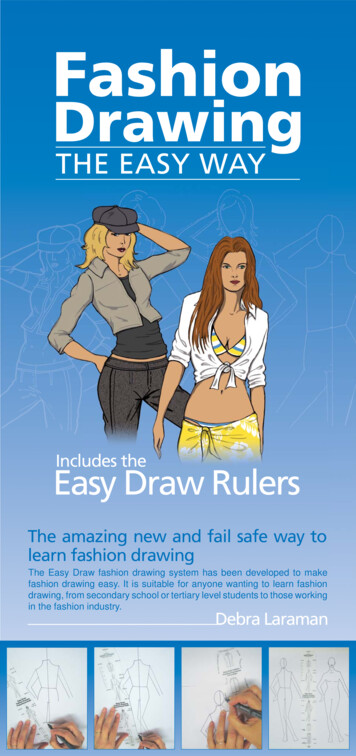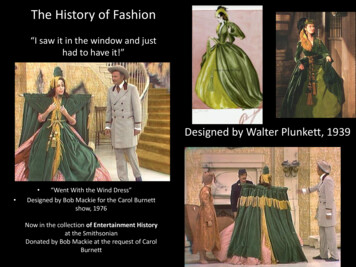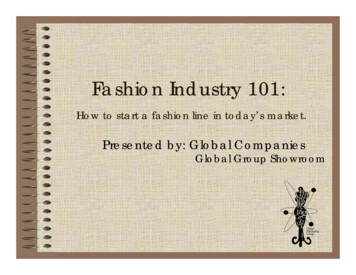
Transcription
8th INTERNATIONAL TEXTILE, CLOTHING & DESIGN CONFERENCE – Magic World of TextilesOctober 02nd to 05th 2016, DUBROVNIK, CROATIADIGITAL FASHION – HOW AND WHEN?Heikki MATTILAAbstract:Virtual Reality and 3D systems are widely in use in many industries, both for design and marketing.Automobiles are designed by 3D systems, and the same images are further used in sales promotion andalso in sales configurations. 3D design systems are also used by several fashion companies. But only a fewgo beyond that and present virtual products in web sites and in configurator applications like the famousSales Wall by Adidas, which is regarded to be the company at the forefront in virtualization in fashion.3D software solutions are widely available. Lectra offers tools for designers while Browzwear, Optitex andClo3D go further by integrating the 3D designs to sales configuration solutions including moving avatars. TheKorean golf wear manufacturer Elrod organizes virtual cat walks for presenting their garments, wherenothing, i.e. models (avatars), garments, cat walk and scenery, is real. The visual quality of avatars andgarments improves continuously. Furthermore, such systems make customized e commerce possible.The aim of the recently completed Horizon 2020 funded project 'fromROLLtoBAG' was to create anintegrated consumer driven local production system with the help of virtual design and digital manufacturing.Consumers connected with mobile devices can customize the avatar, insert own measurements and virtuallytry on garments from suppliers’ collection. Once done the order is transferred to a local manufacturer whichwith digital printing, cutting and unit assembly produces the product and ships to the customer in one day.Besides offering digital market place to brand companies, the objective of the project was to bring garmentproduction back to Europe.Key words: digital sales and manufacturing, consumer driven local production, virtual design, digital salesconfigurations, digital fashion1. IntroductionMost engineering industries have found 3D digital design and virtual reality applications extremely useful inproduct development, marketing and e commerce, primarily due to reduced lead times and savings insampling and prototype materials. 3D sales configurator software makes it possible to market and displayproducts before making them. Audi City in central London brings car dealerships back to city centers bydisplaying virtual instead of real cars [1]. However, such examples from the fashion and textile world are notmany. Yet, 3D software solutions are widely available. Lectra offers tools for designers while Browzwear,Optitex and Clo3D go further by integrating the 3D designs to sales configuration solutions including movingavatars for virtual reality catwalks. The technology and the visual quality of avatars and garments improvecontinuously. The main software suppliers are presented in Figure1.CompanyLectraBrowzwear/ USAChinaUSA3DsoftwareModaris3D FitVstitcher3DRunwayVidyaClo activesoftware3DavataranddisplayFigure 1:. Current suppliers of fashoin industry 3D design and visualization software.1
8th INTERNATIONAL TEXTILE, CLOTHING & DESIGN CONFERENCE – Magic World of TextilesOctober 02nd to 05th 2016, DUBROVNIK, CROATIAAdidas is one of the few apparel firms that seriously implements virtualization on the overall designmarketing life cycle. During the ten year implementation process they have saved the cost of producing wayover one million samples [2]. 3DEXCITE of Dessault Systems assisted Adidas and several other fashioncompanies in 3D visualization, and they estimate that not only time and money can be saved but companiescan respond to changes faster and more effectively [3].Against this background a Horizon 2020 financed Innovation Action project ‘fromROLLtoBAG’, i.e. ConsumerDriven Local Production with the Help of Virtual Design and Digital Manufacturing for fashion and sportsgarments was launched at the beginning of 2015. The objective of the project was to create enabling virtualdesign and sales technology together with enabling digital manufacturing technology and to demonstrate thatconsumer driven on-line local production with no or low inventories can compete with globally operatingchains, and at the end, bring production back to Europe. Consumers were identified to be the driving forcebehind these systems. By offering the consumers a novel and inspiring shopping experience, consumerdriven local production lines can be successfully established. Through the following steps the project aimedto bring the digital shopping experience beyond the state-of-the-art: The enabling virtual design and sales technology needs to be applicable for the consumers to usethrough digital and mobile connections, especially regarding the avatar, 3D sales configuration andinteractive rendering.The modules of enabling digital manufacturing technology, i.e. digital printing, digitally driven cuttingand assembly software are already commercially available, but usually applied to mass productionlines. The ‘from-roll-to-bag’ continuous production line connected to consumer driven digital orderingsystem makes unit production, mass-customization and no or low stocks and lead times possible.Such lines can be installed inside the market, thus enabling the companies to bring production backto Europe.The radically new apparel product construction and pattern technology developed by University ofBorås made the from-roll-to-bag production line physically possible. The new technology will changethe conventional garment construction totally. Number of seams is reduced, material consumptionwill be decreased and assembly will be simplified.The results and benefits are communicated to the creative industry SMEs as well as to consumersby web site, articles, videos and social media, as well as Road-Show Workshops to be organizedjointly with the fashion and textile industry organizations.Nine partners agreed to carry out the project according to the research course presented in Figure 2.Figure 2: Three research partners (Tampere University of Technology, University of Borås, MIRALab), threeICT partners (Cyberlighting, Lectra, AluGroup) and three manufacturing partners (Printscorpio, Salomon,Bivolino) joined forces to carry out the fromROLLtoBAG project.2. The MarketGarment imports to Europe have grown steadily over the past ten years resulting in massive job loss in thetextile and garment industry. Fashion e commerce is expected to grow significantly both in Europe and theU.S. In fact clothing and sporting goods have already a 50 % share in e commerce in UK [4] [5] [6]. Due to along lead time and poor forecasting accuracy the traditional fashion value chain (both brick & mortar and e2
8th INTERNATIONAL TEXTILE, CLOTHING & DESIGN CONFERENCE – Magic World of TextilesOctober 02nd to 05th 2016, DUBROVNIK, CROATIAcommerce) performs poorly. Production orders are allocated six months prior to the selling season, whilecollection design starts even earlier. According to research by Tampere University of Technology and Hjortthe key performance indicators in fashion retail chains in Europe were as follows [7] [8]: Sell-Through (proportion of goods sold at first price) 63 %Lost Sales (potential sales lost due to stock-out) 23 %Inventory turnover 2.9Real mark-up after all discounts 2.0Rate of return in mass e commerce between 40 % and 60 %In mass merchandising the low purchase price is regarded as the corner stone of profitability in order tofacilitate the high cost of the value chain, including low Sell-Through and slow inventory turns. But byeliminating these draw-backs, as mass-customized bespoke value chains do, higher purchase price can betolerated. This in turn makes local manufacturing possible, and bringing production back to Europe becomesreality.3. Concept and ApproachBy implementing the 3D and augmented reality applications to an e commerce web site the consumers willhave an inspiring shopping experience and extremely fast response to their shopping needs. This will beassured by the ‘from-ROLL-to-BAG’ production line, which enables production and delivery of customizedorders rapidly. Inventories will consist of undyed fabrics and accessories, which can be flexibly used for thecustomized products, thus avoiding the problem of having large stocks of ready-made products normallyneeded by e commerce.3.13D Visualization and e CommerceThe consumer is connected to the sales application. By creating an interactive avatar, products from a brandcompany’s collection can be virtually tried on and modified. The sale configurator assists in selecting printsand fabric colors. Once the order is confirmed the product specification data is transferred further to a localon-line manufacturer for production.Figure 3: The enabling virtual design and sales technology and on-line digital manufacturing technology ofthe project.3.2Consumer Driven Local ManufacturingThe enabling digital manufacturing technology consists of a digital printer, a computerized cutter and sewingmachinery for assembly. Fabrics are stored grey, and prints selected by consumer are printed by usingsublimation heat transfer printing for polyester and direct pigment printing for cotton. Only the garment areais printed and the contour cutter follows the edge of the print when cutting. As products are printed and cut3
8th INTERNATIONAL TEXTILE, CLOTHING & DESIGN CONFERENCE – Magic World of TextilesOctober 02nd to 05th 2016, DUBROVNIK, CROATIAone by one the increased material consumption was avoided by use of radically new product constructionand pattern technology. Once the product is ready it is shipped to the consumer.Figure 4: The radically new patterns based on kinetic garment construction theory were developed in orderto maximize wearing comfort and to minimize fabric consumption [9]4. Results vs. State-of-the-ArtThe objectives and the results achieved by the project are in line with various international projects which, bymeans of advanced technology, aim to bring the outsourced production of consumer goods back home, forexample: Open Garments was a FP7 project with the overall objective to create a Manufacturing ServiceProvider (MSP) Business Model enabling individual garments. A new way of design, production andsales of consumer designed and configured garments is based on the provision of individualizedservices and products to customers and partners [10].Horizon 2020, NMP 35 – 2014: Business models with new supply chains for sustainable customerdriven small series production, which aims at returning delocalized manufacturing to Europe. Apparel made for you, an American initiative developing technology which allowsapparel manufacturing to profitably return to North America [11]. Reshoring Initiative, another American initiative, whose mission is to bring good, wellpaying manufacturing jobs back to the United States [12].According to the nature of Innovation Action projects of Horizon 2020, fromROLLtoBAG did not carry outextensive research, but rather by using existing technology and solutions, created a new business model.The system can be further exploited by different beneficiaries. Commercial Internet market place providersand local on-line manufacturers form the business platform and pave a way for brand companies tocommence on-line bespoke garment business. Special technology from software providers will make theoperations possible: Consumers drive the system by selecting, customizing and ordering products of their preference.They can select different brands at one on-line market place, try them on virtually and customizethem.Brand companies can use the system as one channel to the market. They sell directly toconsumers through the on-line service platform by providing collections and product data to the online store operator.Software providers’ role is to sell or lease software to the operators (avatar, 3d design system,sales configurator, pattern design, production planning, PLM, etc.).Commercial Internet market place provider is a multi-brand on-line store without inventory. Thecloud service is offered to the brand companies who are willing to let consumers customize theirpurchase. Orders are passed on to local on-line manufactures for production.Local on-line manufacturers are service companies who receive orders from Commercial Internetmarket place providers and, after making the product, ship it directly to the consumer. Themanufacturer’s inventory consists of grey fabric and basic accessories which can be used for makingdifferent types of garments flexibly.4
8th INTERNATIONAL TEXTILE, CLOTHING & DESIGN CONFERENCE – Magic World of TextilesOctober 02nd to 05th 2016, DUBROVNIK, CROATIAThe competitiveness of the system is far better than with other e commerce retailing channels. The shoppingexperience is inspiring to consumers and up-loaded personal details for avatar creation boost customerloyalty. Lead time from committing to product order from manufacturer to consumers is extremely short.Inventory consists of grey fabric and accessories only, which flexibly can be used for making different kindsof products. Due to the ‘from-hand-to-mouth’ nature of the business excellent retail performance can beachieved when measured by Sell-Through %, Lost Sales %, Inventory turns, Mark-up and Return rate. Risksof obsolescent stock is very low compared to traditional and customized on-line retailing. The resultsquantified by a Business Plan are summarized in Table 1.Table 1: Value Generation in different type of e commerceShopping experienceCustomer loyaltyLead timeInventoriesRetail performanceRisksTraditional on-linefashion retailingTraditionalLowLong (6-8 months)High (turns 2.9)Sell-Through low (67 %)Lost Sales high (23 %)Real mark-up low (2.0)Returns high (50
8th INTERNATIONAL TEXTILE, CLOTHING & DESIGN CONFERENCE – Magic World of Textiles October 02nd to 05th 2016, DUBROVNIK, CROATIA 1 DIGITAL FASHION – HOW AND WHEN? Heikki MATTILA Abstract: Virtual Reality and 3D systems are widely

